Improved State of Charge Estimation for High Power Lithium Ion Batteries Considering Current Dependence of Internal Resistance
Abstract
:1. Introduction
1.1. Current Dependence of Li-ion Batteries
1.2. Existed Algorithms of State of Charge (SOC) Estimations
1.3. Advances of Current Work
2. The Battery Model
2.1. The Overall Scheme
2.2. OCV and Hysteresis
2.3. RC Circuits
3. Identification of Model Parameters
3.1. SOC Dependence of Parameters
3.2. Current Dependence of Parameters
4. Simulation and Validation
4.1. Validation of the Li-ion Model
4.2. SOC Estimation with EKF
4.2.1. Simulation with Initial SOC Error
4.2.2. Simulation with Biased Current Measurement
5. Conclusions and Discussion
Author Contributions
Conflicts of Interest
Appendix A. Temperature Dependence of Model Parameters
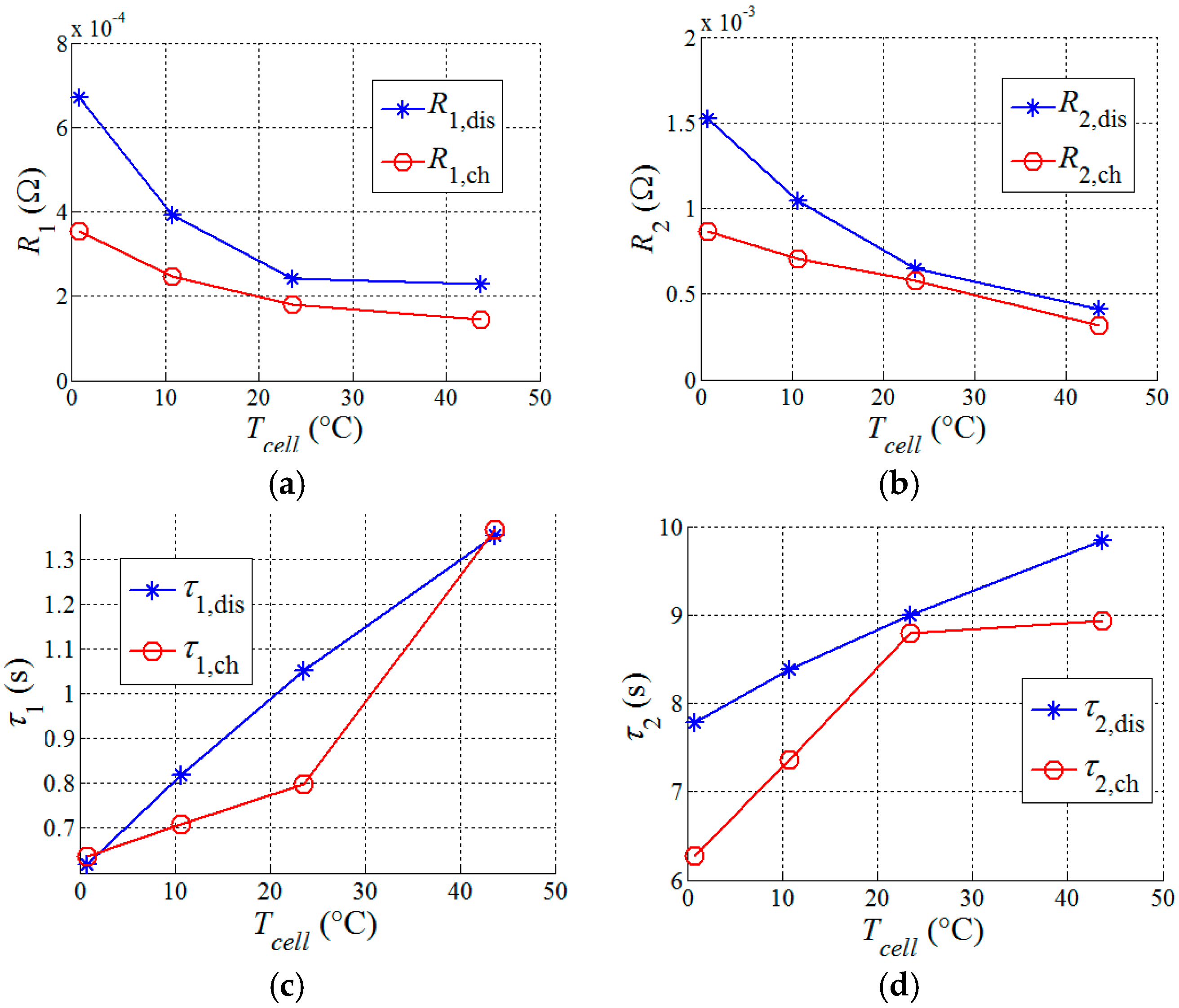
References
- Kuypers, M. Application of 48 Volt for Mild Hybrid Vehicles and High Power Loads; SAE Technical Paper 2014-01-1790; SAE International: Warrendale, PA, USA, 2014. [Google Scholar] [CrossRef]
- Pesaran, A. Choices and Requirements of Batteries for EVs, HEVs, PHEVs a CALSTART Webinar; National Renewable Energy Laboratory: Golden, CO, USA, 2011.
- European Automobile Manufacturers Association. A Review of Battery Technologies for Automotive Applications; European Automobile Manufacturers Association: Brussels, Belgium, 2014. [Google Scholar]
- Plett, G. Extended Kalman filtering for battery management systems of LiPB-based HEV battery packs Part 1: Background. J. Power Sources 2004, 134, 252–261. [Google Scholar] [CrossRef]
- Waag, W.; Kabitz, S.; Sauer, D. Experimental investigation of the lithium-ion battery impedance characteristic at various conditions and aging states and its influence on the application. Appl. Energy 2013, 102, 885–897. [Google Scholar] [CrossRef]
- Waag, W.; Fleischer, C.; Sauer, D. On-line estimation of lithium-ion battery impedance parameters using a novel varied-parameters approach. J. Power Sources 2013, 237, 260–269. [Google Scholar] [CrossRef]
- Xu, X.; Shui, M.; Zheng, W.; Shu, J.; Hui, L.; Xu, L.; Cheng, L.; Feng, L.; Ren, Y. Time-domain simulations of transient response in LiFePO4 cathode lithium ion batteries. Curr. Appl. Phys. 2014, 14, 702–707. [Google Scholar] [CrossRef]
- Maheshwari, A.; Dumitrescu, M.; Destro, M.; Santarelli, M. Inverse parameter determination in the development of an optimized lithium iron phosphate e Graphite battery discharge model. J. Power Sources 2016, 307, 160–172. [Google Scholar] [CrossRef]
- Noren, D.; Hoffman, M. Clarifying the Butler-Volmer equation and related approximations for calculating activation losses in solid oxide fuel cell models. J. Power Sources 2005, 152, 175–181. [Google Scholar] [CrossRef]
- Ratnakumar, B.; Smart, M.; Whitcanack, L.; Ewell, R. The impedance characteristics of Mars Exploration Rover Li-ion batteries. J. Power Sources 2006, 159, 1428–1439. [Google Scholar] [CrossRef]
- Waag, W.; Fleischer, C.; Sauer, D. Adaptive on-line prediction of the available power of lithium-ion batteries. J. Power Sources 2013, 242, 548–559. [Google Scholar] [CrossRef]
- Huang, J.; Zhang, J.; Li, Z.; Song, S.; Wu, N. Exploring Differences between charge and discharge of LiMn2O4/Li half-cell with dynamic electrochemical impedance spectroscopy. Electrochim. Acta 2014, 131, 228–235. [Google Scholar] [CrossRef]
- Srinivasan, V.; Newman, J. Discharge model for the lithium iron-phosphate electrode. J. Electrochem. Soc. 2004, 151, A1517–A1529. [Google Scholar] [CrossRef]
- Wang, C.; Kasavajjula, U.S.; Arce, P.E. A discharge model for phase transformation electrodes: Formulation, experimental validation, and analysis. J. Phys. Chem. C 2007, 111, 16656–16663. [Google Scholar] [CrossRef]
- Dubarry, M.; Vuillaume, N.; Liaw, B.Y. From single cell model to battery pack simulation for Li-ion batteries. J. Power Sources 2009, 186, 500–507. [Google Scholar] [CrossRef]
- Chiang, Y.H.; Sean, W.Y.; Ke, J.C. Online estimation of internal resistance and open-circuit voltage of lithium-ion batteries in electric vehicles. J. Power Sources 2011, 196, 3921–3932. [Google Scholar] [CrossRef]
- Liaw, B.Y.; Nagasubramanian, G.; Jungst, R.G.; Doughty, D.H. Modeling of lithium ion cells—A simple equivalent-circuit model approach. Solid State Ion. 2004, 175, 835–839. [Google Scholar]
- Dubarry, M.; Liaw, B.Y. Development of a universal modeling tool for rechargeable lithium batteries. J. Power Sources 2007, 174, 856–860. [Google Scholar] [CrossRef]
- Hu, Y.; Yurkovich, S.; Guezennec, Y.; Yurkovich, B.J. A technique for dynamic battery model identification in automotive applications using linear parameter varying structures. Control Eng. Pract. 2009, 17, 1190–1201. [Google Scholar] [CrossRef]
- Hu, Y.; Yurkovich, S. Linear parameter varying battery model identification using subspace methods. J. Power Sources 2011, 196, 2913–2923. [Google Scholar] [CrossRef]
- Chen, M.; Rincon-Mora, G. Accurate electrical battery model capable of predicting runtime and IV performance. IEEE Trans. Energy Convers. 2006, 21, 504–511. [Google Scholar] [CrossRef]
- Einhorn, M.; Conte, F.; Kral, C.; Fleig, J. Comparison, selection, and parameterization of electrical battery models for automotive applications. IEEE Trans. Power Electron. 2013, 28, 1429–1437. [Google Scholar] [CrossRef]
- Saxena, S.; Raman, S.R.; Saritha, B.; John, V. A novel approach for electrical circuit modeling of Li-ion battery for predicting the steady-state and dynamic I–V characteristics. Sādhanā 2016, 41, 479–487. [Google Scholar]
- Andre, D.; Meiler, M.; Steiner, K.; Walz, H.; Soczka-Guth, T.; Sauer, D.U. Characterization of high-power lithium-ion batteries by electrochemical impedance spectroscopy. II: Modelling. J. Power Sources 2011, 196, 5349–5356. [Google Scholar] [CrossRef]
- Hu, X.; Li, S.; Peng, H. A comparative study of equivalent circuit models for Li-ion batteries. J. Power Sources 2012, 198, 359–367. [Google Scholar] [CrossRef]
- Verbrugge, M.; Tate, E. Adaptive state of charge algorithm for nickel metal hydride batteries including hysteresis phenomena. J. Power Sources 2004, 126, 236–2449. [Google Scholar] [CrossRef]
- Huria, T.; Ludovici, G.; Lutzemberger, G. State of charge estimation of high power lithium iron phosphate cells. J. Power Sources 2014, 249, 92–102. [Google Scholar] [CrossRef]
- Lee, S.; Kim, J.; Lee, J.; Cho, B. State-of-charge and capacity estimation of lithium-ion battery using a new open-circuit voltage versus state-of-charge. J. Power Sources 2008, 185, 1367–1373. [Google Scholar] [CrossRef]
- Plett, G. Extended Kalman filtering for battery management systems of LiPB-based HEV battery packs Part 2. Modeling and identification. J. Power Sources 2004, 134, 262–276. [Google Scholar] [CrossRef]
- Plett, G. Extended Kalman filtering for battery management systems of LiPB-based HEV battery packs Part 3. State and parameter estimation. J. Power Sources 2004, 134, 277–292. [Google Scholar] [CrossRef]
- Hu, X.; Li, S.; Peng, H.; Sun, F. Robustness analysis of State-of-Charge estimation methods for two types of Li-ion batteries. J. Power Sources 2012, 217, 209–219. [Google Scholar] [CrossRef]
- Xing, Y.; He, W.; Pecht, M.; Tsui, K. State of charge estimation of lithium-ion batteries using the open-circuit voltage at various ambient temperatures. Appl. Energy 2014, 113, 106–115. [Google Scholar] [CrossRef]
- He, W.; Williard, N.; Chen, C.; Pecht, M. State of charge estimation for Li-ion batteries using neural network modeling and unscented Kalman filter-based error cancellation. Int. J. Electr. Power Energy Syst. 2014, 62, 783–791. [Google Scholar] [CrossRef]
- Marongiu, A.; Nubbaum, F.; Waag, W.; Garmendia, M.; Sauer, D. Comprehensive study of the influence of aging on the hysteresis behavior of a lithium iron phosphate cathode-based lithium ion battery—An experimental investigation of the hysteresis. Appl. Energy 2016, 171, 629–645. [Google Scholar] [CrossRef]
- Dreyer, W.; Jamnik, J.; Guhlke, C.; Huth, R.; Moskon, J.; Gaberscek, M. The thermodynamic origin of hysteresis in insertion batteries. Nat. Mater. 2010, 9, 448–453. [Google Scholar] [CrossRef] [PubMed]
- Hoque, M.; Hannan, M.; Mohamed, A. Charging and discharging model of lithium-ion battery for charge equalization control using particle swarm optimization algorithm. J. Renew. Sustain. Energy 2016, 8. [Google Scholar] [CrossRef]
- Kalman, R.E. A new approach to linear filtering and prediction problems. J. Basic Eng. 1960, 82, 35–45. [Google Scholar] [CrossRef]
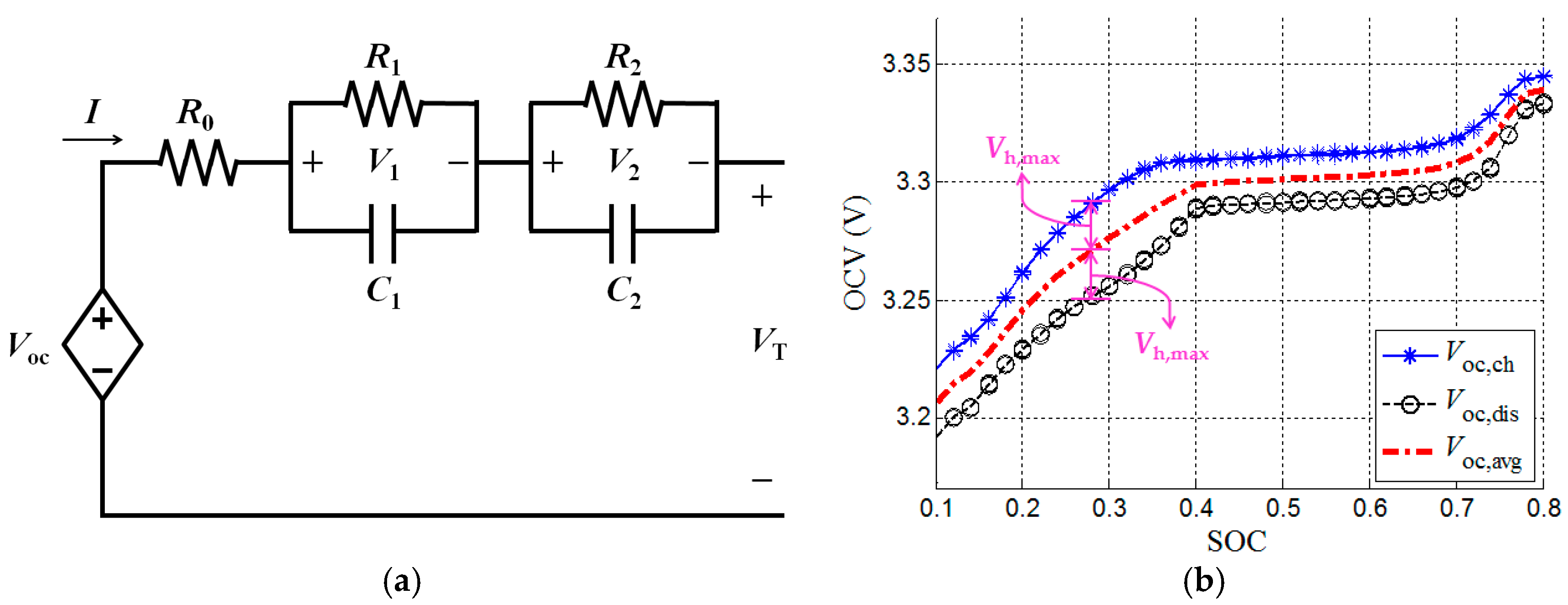
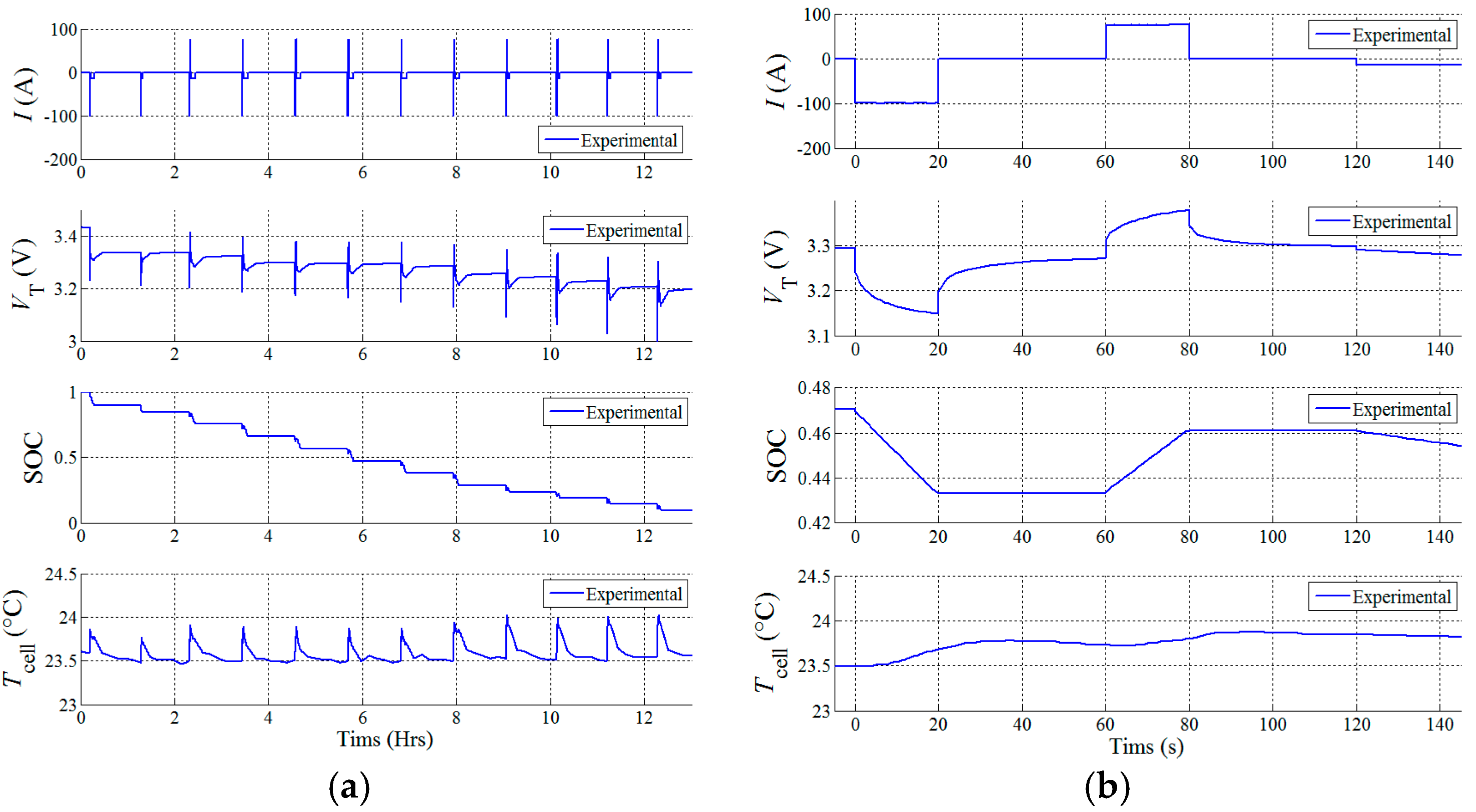
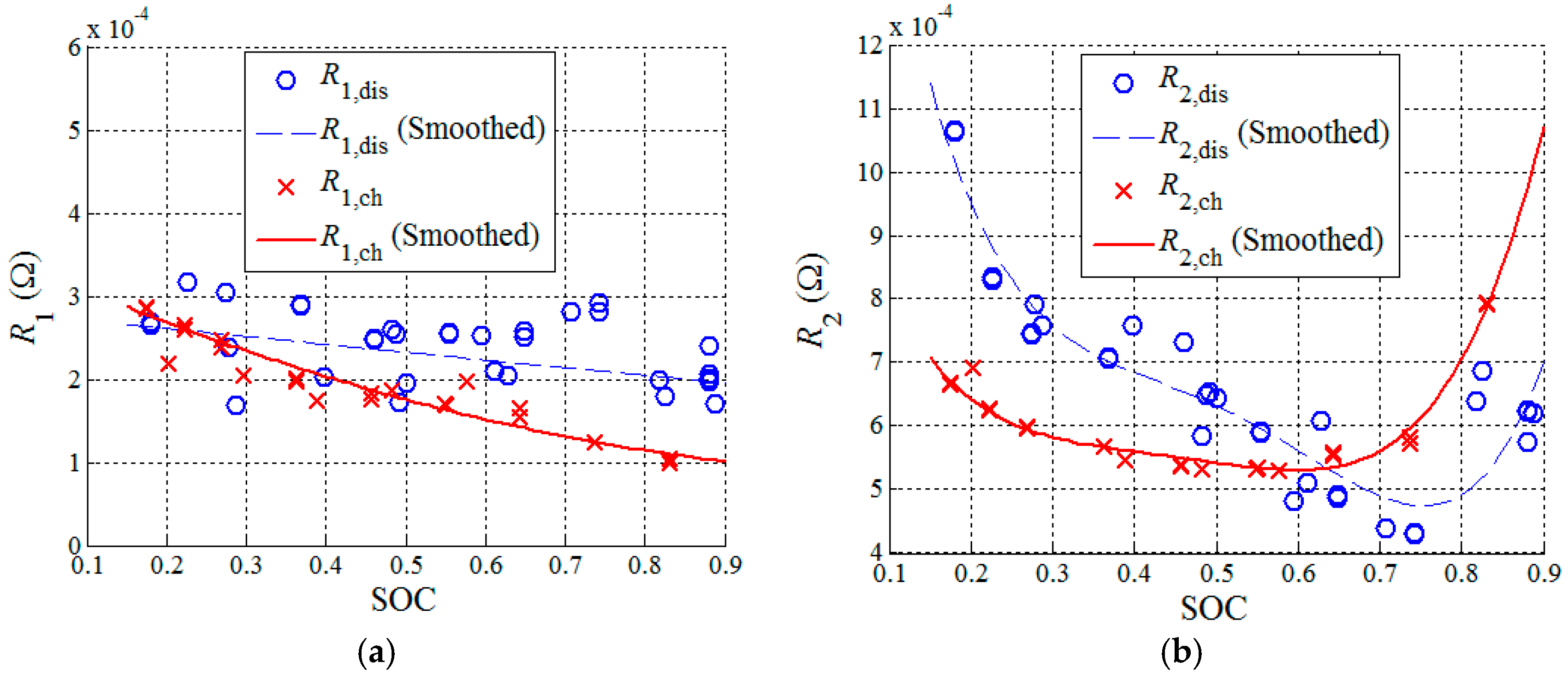

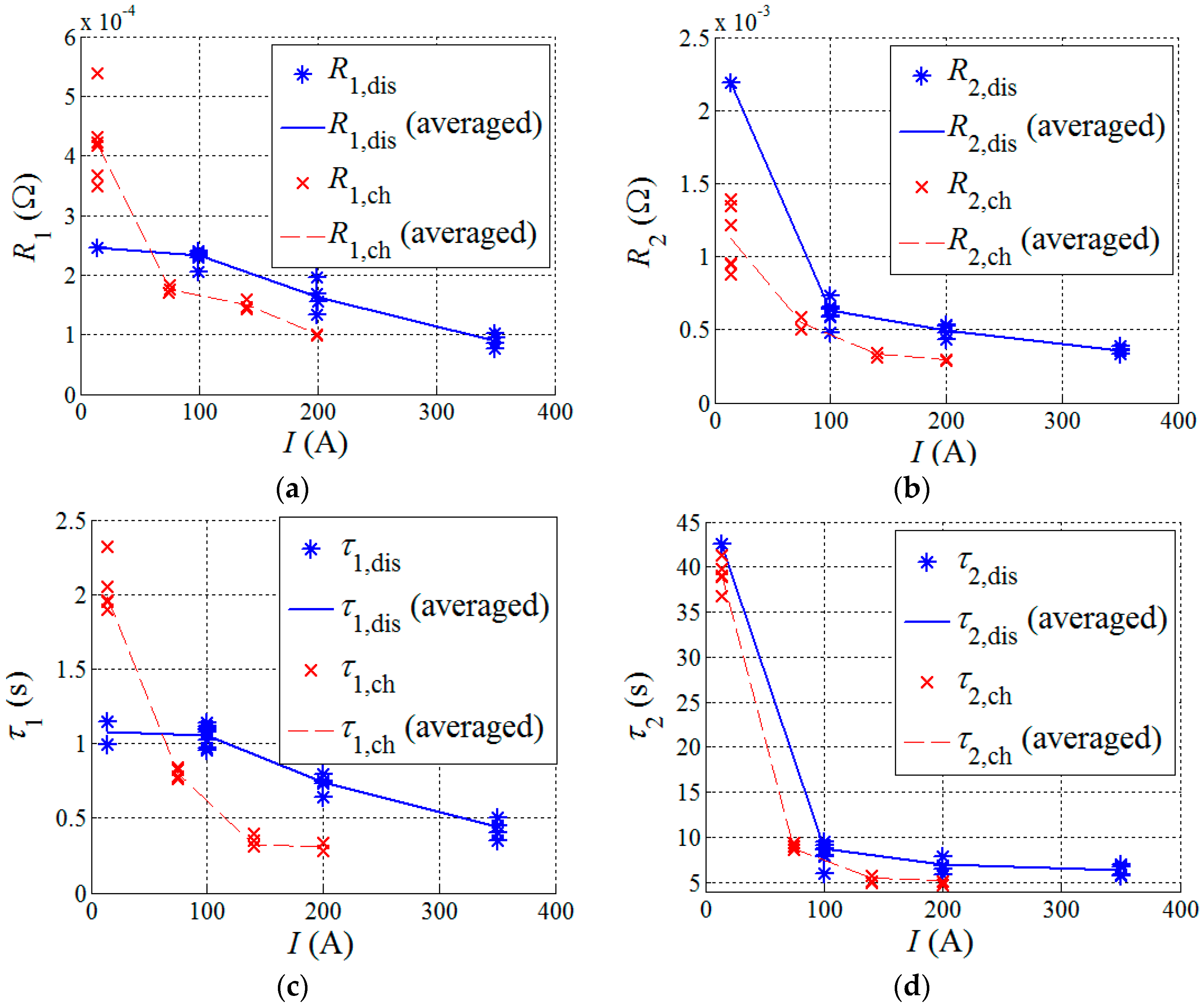
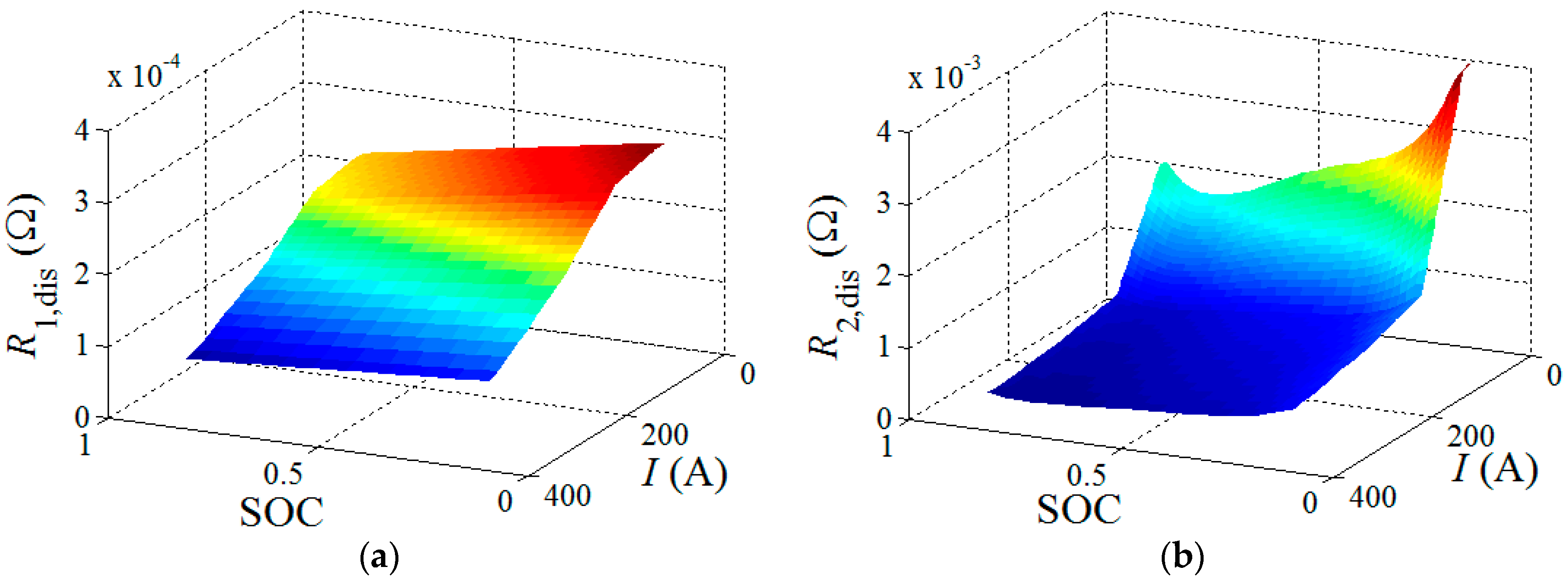
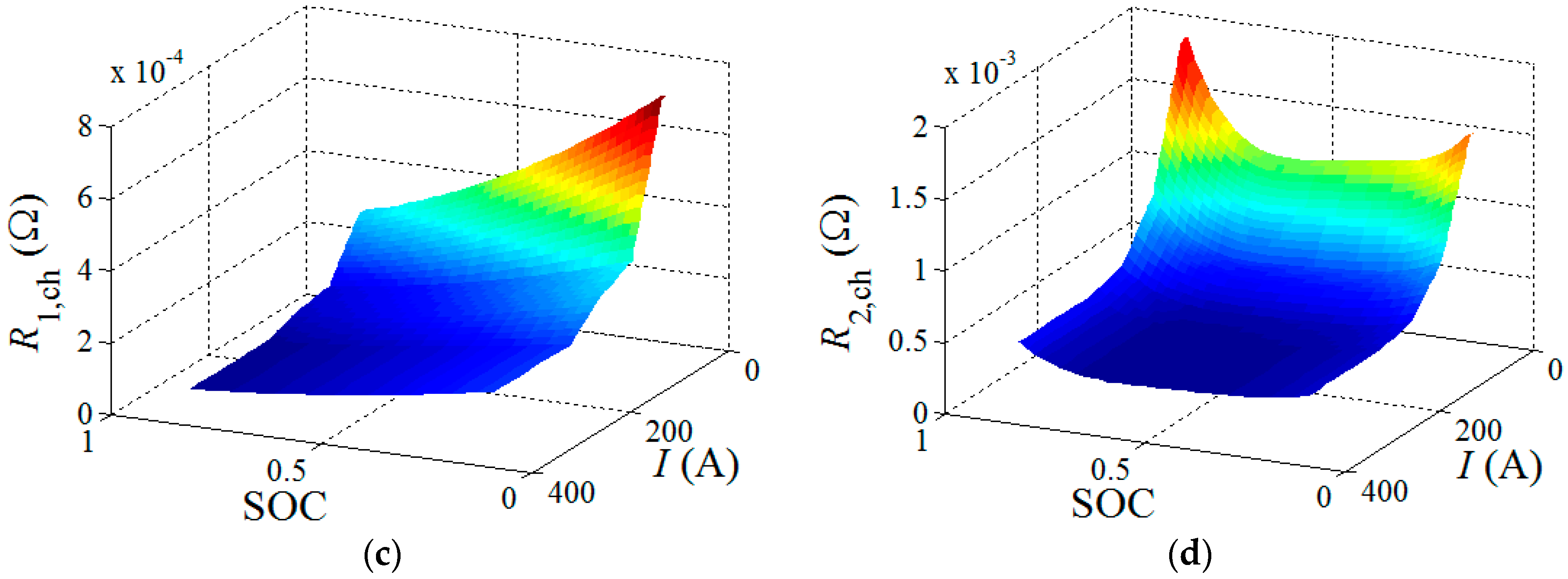
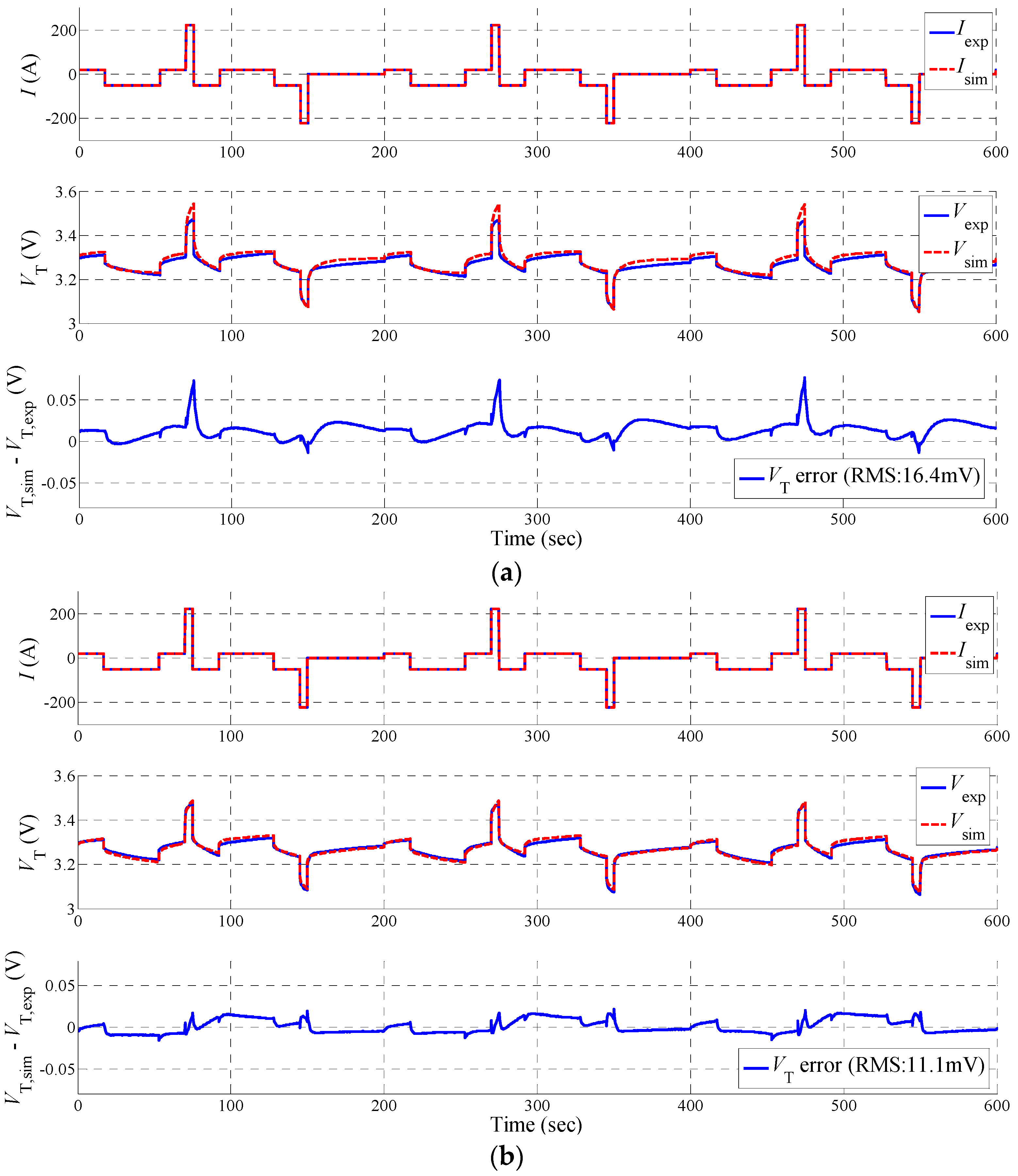
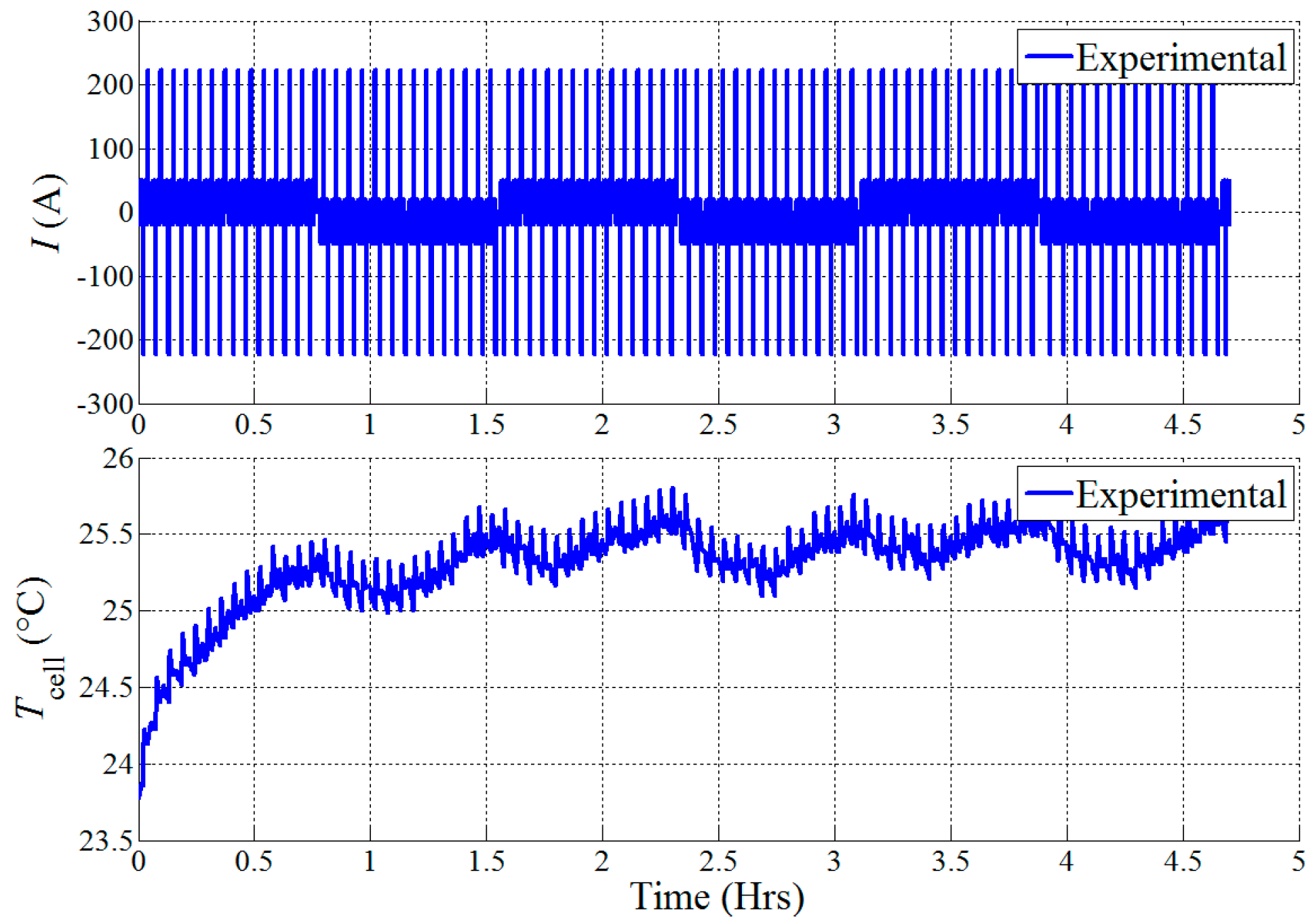
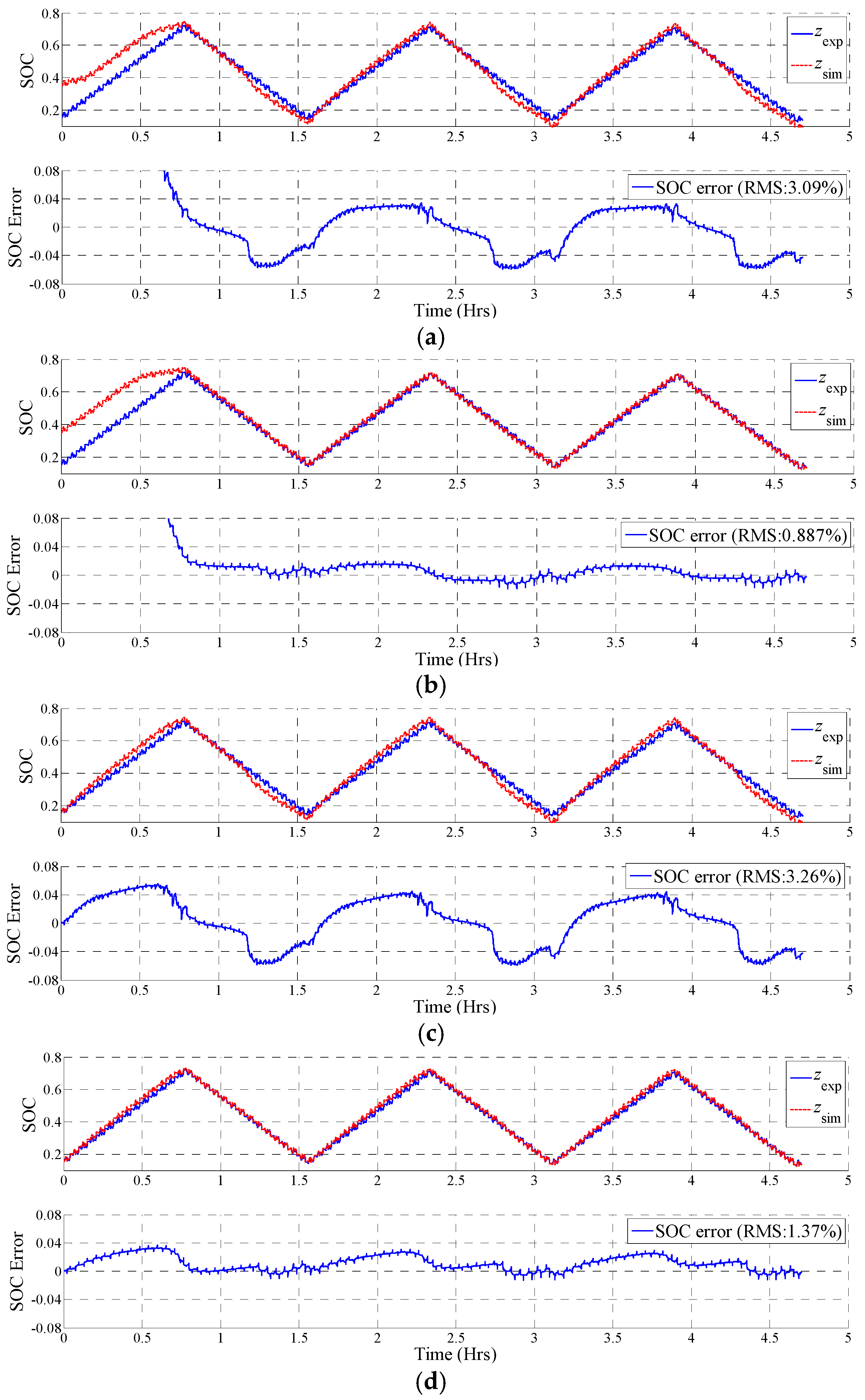
| Discharge | Charge |
|---|---|
| 14 A/60 s | 14 A/60 s |
| 100 A/20 s (Baseline) | 75 A/20 s (Baseline) |
| 200 A/20 s | 140 A/20 s |
| 350 A/10 s | 200 A/10 s |
| Simulation Cases | Errors | With Current Independent Parameters | With Current Dependent Parameters |
|---|---|---|---|
| Simulation of the Li-ion Model | RMS error of VT | 16.4 mV | 11.1 mV |
| SOC estimation using EKF given 20% initial SOC error | Bounds of SOC error | −6%–4% | −2%–2% |
| RMS error of SOC | 3.09% | 0.89% | |
| SOC estimation using EKF given 0.5 A biased current measurement | Bounds of SOC error | −7%–4% | −1%–3% |
| RMS error of SOC | 3.26% | 1.37% |
© 2017 by the authors. Licensee MDPI, Basel, Switzerland. This article is an open access article distributed under the terms and conditions of the Creative Commons Attribution (CC BY) license (http://creativecommons.org/licenses/by/4.0/).
Share and Cite
Wu, C.; Fu, R.; Xu, Z.; Chen, Y. Improved State of Charge Estimation for High Power Lithium Ion Batteries Considering Current Dependence of Internal Resistance. Energies 2017, 10, 1486. https://doi.org/10.3390/en10101486
Wu C, Fu R, Xu Z, Chen Y. Improved State of Charge Estimation for High Power Lithium Ion Batteries Considering Current Dependence of Internal Resistance. Energies. 2017; 10(10):1486. https://doi.org/10.3390/en10101486
Chicago/Turabian StyleWu, Cunxue, Rujian Fu, Zhongming Xu, and Yang Chen. 2017. "Improved State of Charge Estimation for High Power Lithium Ion Batteries Considering Current Dependence of Internal Resistance" Energies 10, no. 10: 1486. https://doi.org/10.3390/en10101486
APA StyleWu, C., Fu, R., Xu, Z., & Chen, Y. (2017). Improved State of Charge Estimation for High Power Lithium Ion Batteries Considering Current Dependence of Internal Resistance. Energies, 10(10), 1486. https://doi.org/10.3390/en10101486





